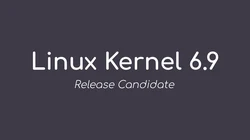Linus Torvalds Announces the First Linux Kernel 6.9 Release Candidate
That's right, it's been two weeks since the release of Linux 6.8, and the merge window for Linux kernel 6.9 is now closed, which means that the time has come for the community to test drive the Release Candidate (RC) development versions, which are usually targeted at early adopters, distro maintainers, and bleeding-edge users.
The final release of Linux kernel 6.9 is expected to hit the streets in mid-May 2024, either on May 12th or May 19th, which depends on how many Release Candidate (RC) milestones Linus Torvalds will release until then.
Update (by Roy)
-
Kernel prepatch 6.9-rc1
The 6.9-rc1 kernel prepatch is out for testing. Linus Torvalds described some rather large updates to the core kernel code that are coming for 6.9...
-
Linux 6.9-rc1
So two weeks have passed, the merge window is over, and v6.9-rc1 is tagged and pushed out.
This merge window looks to be fairly normal. If you look at the diffs, you'd think that the bulk of all the changes are AMD GPU header files again, and you'd not be entirely wrong. About 40% of the whole 6.9rc1 patch is indeed just the auto-generated AMD GPU definitions. I wish this was unusual, but it's a pattern.
Anyway, while that is a lot of the actual changes by pure line numbers, it's all just basically noise and not meaningful in the big picture.
In contrast, what _is_ meaningful is a couple of very core updates. The timer subsystem had a fairly big rewrite, to have per-cpu timer wheels to improve performance of timers, which can be a big deal particularly for networking. The other fairly notable core update is to the workqueue subsystem, where one notable addition is for BH workqueue support. That's notable mainly because it means we finally have a way away from tasklets. The tasklet interface has basically been deprecated for a long while, but we've never really had any good alternatives (with threaded interrupt handlers being one suggested use-case, but not realistic in many cases).
The core updates should be entirely invisible to users, as they don't involve any semantic changes, just expanded capabilities. Of course, being somewhat big changes, they did cause a few issues, but we've hopefully already caught all the big deals.
Anyway, there's obviously also all the usual updates, and even when you ignore the recurring AMD header drop more than half of actual patch is - as usual - various driver updates all over. And all the other usual suspects: architecture updates, various filesystems (old ntfs core removal might be worth noting), core networking, VM and kernel. And tooling and documentation.
Please commence testing,
Linus -
2024-03-16 [Older] Linux Distributors' Alliance Continues Long-Term Support for Linux 4.14
BetaNews:
-
Linux 6.9-rc1 provides a glimpse into the future of the open source kernel
Linus Torvalds has officially announced the release of Linux 6.9-rc1, marking the end of the merge window for this version. As usual, the update brings a ton of changes, with a significant portion attributed to AMD GPU header files. But let's not get bogged down by the sheer volume of these updates; the real excitement lies in the core improvements that promise to enhance the kernel's performance.
Two major updates steal the spotlight in this release: the timer subsystem and the workqueue subsystem. The timer subsystem has undergone a substantial rewrite, introducing per-CPU timer wheels. This enhancement is poised to boost the performance of timers, which is especially crucial for networking operations. On the other hand, the workqueue subsystem now supports BH workqueue support, providing a much-needed alternative to the long-deprecated tasklet interface.
The Register:
-
First release candidate of Linux kernel 6.9 looks 'fairly normal,' says Torvalds
Linus Torvalds just announced the first RC of 6.9 on the Linux Kernel mailing list, saying it "looks to be fairly normal", although it's a recordbreaker in size.
He did call out a few changes in RC-1 of kernel 6.9, which should be ready in roughly mid-May, as especially noteworthy.
One is a very old feature that's being shown the door: the original in-kernel NTFS driver. No, this doesn't mean Linux won't be able to use Windows disks any more – it's the reverse: it will be better able to handle them.
Linux has no fewer than three FOSS drivers for NTFS. Of these, the newest and most capable is called ntfs3, submitted by Paragon Software back in 2020, finally accepted in mid-2021 and released in kernel version 5.15.
Rohan Timalsina:
-
Linux Kernel 6.8 Released: New Features and Hardware Support
Linus Torvalds recently announced the release of Linux kernel 6.8, the latest stable version of the Linux kernel. This update brings a plethora of new features and improvements, making it a significant upgrade for many users.
[...]
Virtualization Enhancements: Kernel 6.8 introduces LAM (Linear Address Masking) virtualization on Intel processors for KVM guests and guest-first memory support for KVM, improving virtualization performance and flexibility.
Filesystem Support: The update expands filesystem support with a basic online check and repair mechanism for Bcachefs. It also enables online fsck checks without unmounting for XFS, faster reads for small blocks for Ext4, new mount flag to disable the free block cache and use of page folios for Btrfs, subpage compression and low-memory performance improvements for EROFS, and SMB file system gains block and symbolic device files creation for SMB.
Hardware Compatibility: This kernel boasts improved hardware compatibility with support for the Broadcom BCM2712 processor in Raspberry Pi 5, AMD’s WBRF Wi-Fi feature, and Intel’s Xe graphics with a new DRM driver.

